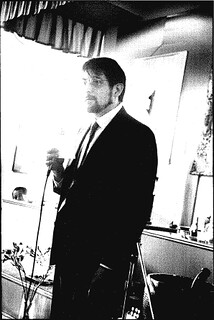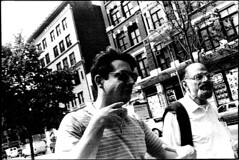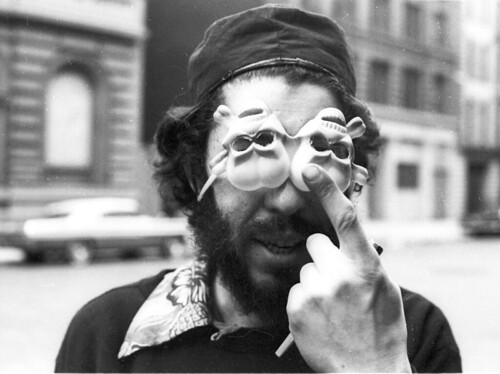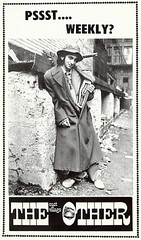 Paula Litsky Bob Rosenthal at Ginsberg’s funeral.
Paula Litsky Bob Rosenthal at Ginsberg’s funeral.It’s the last day of National Poetry Month, so here’s the final installment of our interview with Bob Rosenthal, conducted at Allen Ginsberg’s old 12th Street apartment, where Mr. Rosenthal worked as his secretary for nearly two decades. (Parts one, two, and three of this leisurely conversation ran last week.) As Ginsberg grew older and ill, his assistant followed him to a 14th Street loft purchased from the painter Larry Rivers; when Ginsberg died in 1997, Mr. Rosenthal became executor of the poet’s estate and guardian of one of his last meals.
Allen’s Addictions
Allen always had some pot around – he was a pot propagandist and so if a joint was being passed around and someone was going to take a photograph he would grab the joint so he’s got it. But actually, I rarely ever saw him smoke. He had pot for boyfriends – it’s a good line: “Oh, you want to come up and smoke?” It was really for them. He would go to LSD conventions with the big guys – the Fitz Hugh Ludlow Library guys, Huxley and all those guys. They would give him acid and he would come home and put it in the refrigerator and that was cute. There was a little vial of LSD and it said “Do not take without permission of Allen or Bob” – so I guess Bob had permission. So that was nice. But I never saw him on LSD. Read more…
 Rosenthal and Ginsberg.
Rosenthal and Ginsberg.Earlier this week, Allen Ginsberg’s secretary of 20 years, Bob Rosenthal, shared memories of his former employer – some of which will be included in a memoir he recently completed, “Straight Around Allen.” Speaking to The Local at Ginsberg’s former apartment on East 12th Street, where the two worked alongside each other for so long, he recalled the great poet’s daily routine, his tastes in literature and music, his mail and telephone communications, and his ways with money. Today, in our second installment, Mr. Rosenthal talks about Ginsberg’s social sphere during his two decades in the so-called poets building. Check back tomorrow for still more from this candid interview.
Allen’s East Village
People would always call Allen and say, “Allen, come to my shangri-la in Hawaii,” and here or there. He would never go. A vacation for Allen was coming back and having nothing to do in the East Village. He would often go to the poetry readings at St. Mark’s. He loved the mushroom barley soup at the Kiev. And The New York Times – he just loved it. He hung around Tompkins Square, wrote a lot of one-line poems about skinheads there. And he was a natural. I think because he always felt free here. Read more…
 Bob Simmons Tuli Kupferberg
Bob Simmons Tuli KupferbergThe funniest part of reminiscing about the uber-subversive East Village Other for The New York Times is that the latter set me on the road to rebellion before the former was even founded in 1965. I’m told I was reading by age four and within a few years the first section I grabbed when the Sunday Times arrived every weekend was the Book Review. The Grove Press ads kidnapped my imagination: Who was this Alain Robbe-Grillet guy and how do you pronounce his name? Why was William Burroughs considered so dangerous and did his characters have meals while wearing no clothes? And speaking of clothes, how come the girls on Grove’s covers wore so little?
Obviously my nascent libido was ready for plucking, but my fascination was not simply sexual. I wanted to know why in the land of the First Amendment some had wanted to ban these books.
I bought my first issue of the Village Voice in February 1966; it contained an obituary of the abstract expressionist Hans Hofmann. Already a Dylan fan, I scanned the ads for folk clubs and was absolutely smitten by bohemia. The first girl who won my heart in elementary school was Jessica Hentoff (I don’t recall my feelings being reciprocated) and her father Nat wrote for the Voice. Soon I picked up the Voice’s competitor, The East Village Other.
No friends’ parents wrote for EVO. Scruffier, funnier and dirtier than the Voice, EVO was not simply about bohemia, it was an anarchist’s bomb in newsprint hurled at the bourgeoisie. Even at my tender age, I knew that I didn’t like the world that grown-ups had created. The troublemakers at The Other were expressing themselves in ways I could only daydream about at that point. Read more…
 EVO poster showing Mr. Frick.
EVO poster showing Mr. Frick.Charlie Frick was a rock n’ roll writer and photographer for The East Village Other. He was a network television cameraman and in more recent years has become an independent media consultant. An original light box is among the artifacts he rescued from EVO’s last office in the Law Commune at 640 Broadway. Writing in 1979 for an Alternative Media Syndicate publication (hence at least one instance of “alternative” language), he described the “controlled artistic anarchy” of psychedelic design.
Tripping the Lightbox Fantastic
For more on “Blowing Minds: The East Village Other, the Rise of Underground Comix and the Alternative Press, 1965-72,” read about the exhibition here, and read more from EVO’s editors, writers, artists, and associates here.








